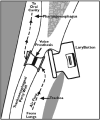Further experience with modification of an intraluminal button for hands-free tracheoesophageal speech after laryngectomy
- PMID: 19853175
- PMCID: PMC4077586
- DOI: 10.1016/S0022-3913(09)60185-2
Further experience with modification of an intraluminal button for hands-free tracheoesophageal speech after laryngectomy
Abstract
Tracheoesophageal (TE) speech using a voice prosthesis and hands-free speaking valve with an intraluminal attachment is the gold standard for voice restoration after total laryngectomy. Modification of a standard self-retaining silicone cannula or laryngectomy button often aids in the attachment of a speaking valve within the tracheal lumen for hands-free TE speech production. An increased number of laryngectomized individuals are able to achieve hands-free TE speech when the standard length, flange, and diameter of a silicone button is customized to accommodate individual tracheostomal contours. A technique is presented for modification of a standard silicone laryngectomy button to facilitate hands-free TE speech after total laryngectomy.
Figures










References
-
- Singer MI. Tracheoesophageal speech: vocal rehabilitation after total laryngectomy. Laryngoscope. 1983;93:1454–65. - PubMed
-
- Hilgers FJ, Ackerstaff AH. Development and evaluation of a novel tracheostoma button and fixation system (Provox LaryButton and LaryClip adhesive) to facilitate hands-free tracheoesophageal speech. Acta Otolaryngol. 2006;126:1218–24. - PubMed
-
- Lemon JC, Lewin JS, Chambers MS, Martin JW. Modification of the Barton button for tracheoesophageal speech: an innovative maxillofacial prosthetic technique. J Prosthet Dent. 2002;87:236–9. - PubMed
-
- Lewin JS, Lemon J, Bishop-Leone JK, Leyk S, Martin JW, Gillenwater AM. Experience with Barton button and peristomal breathing valve attachments for hands-free tracheoesophageal speech. Head Neck. 2000;22:142–8. - PubMed
MeSH terms
Substances
Grants and funding
LinkOut - more resources
Full Text Sources

